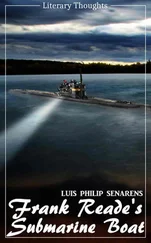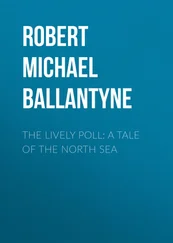Frank Reade's Submarine Boat „The Explorer“; or: to the North Pole Under the Ice by Luis Philip Senarens
CHAPTER I. – THE NEW INVENTION.
A report had gained extensive circulation that Frank Reade, Jr., of Readestown, U. S. A., had brought out a new invention.
This rumor spread far and wide, and created tremendous excitement.
Everybody to-day is deeply interested in the marvelous mechanical productions of this young prince of invention.
The son of Frank Reade, himself a noted inventor, Frank Reade, Jr., came honestly by his talent.
Almost a boy in years, the young inventor occupies a place in the annals of fame much to be envied by any of our progressive American youths.
Tall, handsome and affable, he was a conspicuous figure anywhere, and always popular.
Readestown was a handsome little town, merging into a city, and founded by the senior Reade.
Here Frank Reade, Jr., had established his shops and machine works for the special construction of his inventions.
But, as the opening lines of our story intimates, Frank Reade, Jr., had produced a new invention.
Yielding to inquiry, Frank Reade, Jr., vouchsafed the information that it was not like any previous inventions.
The electric air-ship had played its part, but this time Frank had decided upon a radical departure from his previous effort.
“And is it true, Mr. Reade,” asked a neighbor and friend, “that you will take Barney and Pomp with you upon this projected new trip of yours?”
“It is,” replied Frank, with a smile. “Indeed, I could ill afford to spare two such faithful fellows.”
As it happened the parties mentioned stood by and within hearing.
One was a powerful black, short and sturdy, with a genial countenance.
The other was a genuine full-bred Celt, with broad mug and shrewd twinkling blue eyes, and hair as red as the glow of an autumn sunset.
“Begorra, I knew well Misther Frank wud niver lave me at home!” cried Barney, with a comical grimace; “there’s the naygur, shure it moight be him!”
“Don’ yo’ flattah yo’sef, yo’ big I’ish chump,” returned Pomp, politely. “I jes’ reckon Marse Frank pay mo’ ‘tention to me dan he eber do fo’ yo’.”
“Hurroo! Wud ye hear ther Afrikan talk!” cried Barney, derisively. “Shure, ye’d think Misther Frank cudn’t invint widout him!”
“I jes’ reckon dat de man wha’ invented yo’ neber did no mo’ wo’k,” retorted Pomp.
“To be shure av that, naygur,” replied Barney, “‘twas so good an’ foine a job he niver cud betther it.”
Everybody laughed at this.
Barney and Pomp were always digging at each other, though really the warmest of friends.
“Well, Frank,” continued the neighbor, “when will you reveal to your friends the nature of your new invention?”
“Now,” replied Frank, with a smile.
“Indeed?”
“I mean it.”
The neighbor was surprised.
“What may it be, then? A new kind of flying machine?”
“No,” replied Frank quietly, “it is far different from that. It is nothing more than a submarine boat.”
“You don’t mean it?”
“Yes.”
“Where will you go with a submarine boat?”
“To the North Pole.”
“Under water?”
“Exactly. As yet nobody has succeeded in reaching that coveted point. Now, I propose to attempt it in a novel manner. If I cannot get there over the ice, I shall go there under it.”
His listener was astounded.
“Whew!” he exclaimed, with a deep whistle, “that beats me!”
“If you will step this way I will be glad to show you the new boat!”
“Of course I will.”
The neighbor, whose name was Alexander Harmon, followed Frank through the big gate.
Across the broad yard they went to the high arched door of a long brick building or store house.
Frank threw open these doors.
Harmon beheld a wonderful sight.
There upon stocks was the submarine boat.
In all his life Harmon had never seen the like.
He had been a sea captain once himself, and knew the lines of a boat well.
But he had never seen anything more beautiful than this.
“Upon my word, Frank,” he exclaimed, “you have outdone yourself!”
“I think the Explorer is built on good lines,” said Frank, modestly.
“You are just right.”
The Explorer, which was the name given the submarine boat, was a long, cylindrical craft, with a sheer-pointed bow, carrying a huge steel ram on the end, shaped like a knife.
“The hull is of solid steel,” said Frank. “But, though strong and tough, not too heavy.”
The submarine vessel tapered off in the stern to the shape of a fish, while upon the shelving deck or whale-like back were fins or plates of steel.
“The fins keep the boat steady under water,” said Frank.
A platform, with a railing extended along each side of the craft, with a gang-ladder leading up to the hurricane deck and pilot-house, which was upon the vessel’s bow.
Here a search-light was placed.
“Step into the pilot-house,” said Frank, “and I will endeavor to explain to you how the boat’s machinery works.”
Harmon at once complied.
Frank closed the door behind him.
They were in a sort of vestibule made of plates of steel, with a curious shaped pump and lines of hose visible.
“When the boat is submerged,” said Frank, explanatively, “and we wish to go out upon deck, we simply step from the pilot-house into the vestibule, closing the doors. The water is then let in and we open the door and walk out. When we come in we enter this vestibule, close the door, and the water is pumped out. Then we can go back into the pilot-house safely.”
Harmon looked astonished.
“Ah, yes!” he cried, “but please explain how you can walk out on the deck while the boat is under water.”
Frank smiled.
“There are diving suits,” he said, pointing to several hanging up. “We put those on. The knapsack on the back is the storage reservoir for chemically manufactured air, which keeps us supplied for hours under water.”
They passed now into the pilot-house.
Here were the steering apparatus and the nautical instruments common to all vessels.
The trimmings and fitting of the boat were superb.
From the pilot-house they descended into the cabin.
This was a long compartment elegantly furnished with the finest of appointments.
Staterooms adjoined and electric lights were upon every hand.
A door led out into a vestibule as from the pilot-house and thence to the railed platforms.
Bull’s-eye windows were seven in number on each side of the vessel.
“But how do you make the vessel sink?” asked Harmon.
Frank led the way down in the vessel’s hold.
“Here are the dynamo rooms,” he said. “All the electrical machinery is here. Just aft there are large chambers which we fill with water when we wish to sink, and when we wish to rise the water is expelled in a few seconds by the action of compressed air.”
A few minor points were explained by Frank, and then the inspection ended.
“Wonderful, indeed,” agreed Harmon, as they finally emerged into the yard once more. “I have never seen or heard of its like. It is all ready to launch, I suppose?”
“Perfectly.”
Just back of the building was a deep basin of water, connected with the river by a canal.
Large doors could be thrown open and the Explorer quickly launched upon the waters of the basin.
“When will you make your start for the North Pole?” asked Harmon.
“To-morrow,” replied Frank. “The launch will occur at nine o’clock.”
“All Readestown will be present.”
Читать дальше












